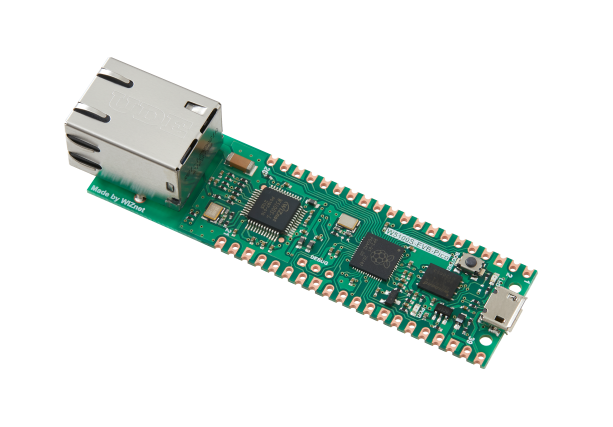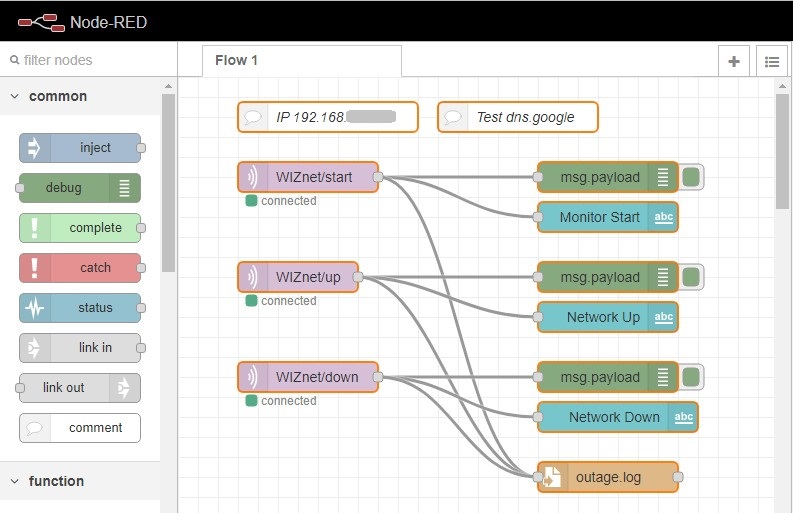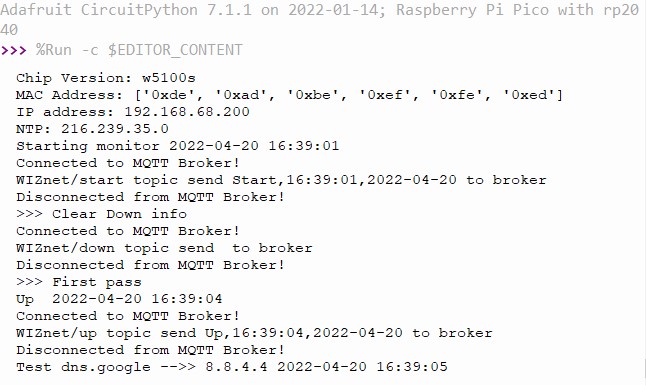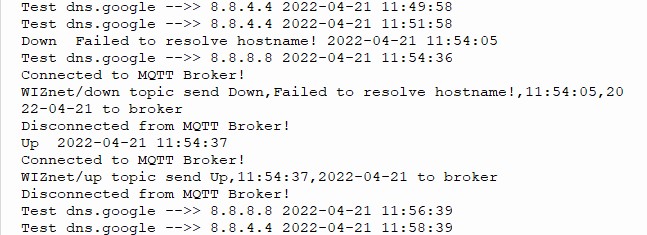Network/internet outage monitor using WIZnet WS5100S-EVB-Pico
Network/internet outage monitor using WIZnet WS5100S-EVB-Pico

- Red LED
x 1
- Green LED
x 1
- 330 ohm resistor
x 2
- Breadboard
x 1
assorted connectors
- Micro USB cable
x 1
- Ethernet cable
x 1
Raspberry Pi - Raspberry Pi
x 1
optional
- Mosquitto Broker
x 1
deployed on RPi or other device
- Node Red
x 1
deployed on RPi
Network/internet outage monitor using WIZnet WS5100S-EVB-Pico
This project uses a WIZnet WS5100S-EVB-Pico attached to a spare Ethernet port on a local router and is used to monitor the Network/Internet for outages. The project was designed after chasing and tracking multiple home Internet outages. I needed times and dates for my Internet provider to track down an ongoing issue I had last year. It did turn out that the issue was the cable coming off of the junction box outside my house. I wanted a device that would sit passively and monitor my network/internet 24/7. The design is a starting point for a more elaborate monitoring device. Please see Future enhancements at the end of the project. I was lucky(?) enough to have an outage in the middle of the night during programming and testing. The monitor did detect and report the outage. I wrote the program after going through all the CircuitPython examples. I borrowed and modified code from may of them. Hope you enjoy and get inspired by the project.The program will:
- Detect the Ethernet cable unplugged from the WS5100S or the Ethernet port on the router
- Detect Network or Internet outages
- Light LEDs to indicate connection ok, cable disconnected and Network/Internet outages
- Display tracking information through the serial port
- Publish program start time, up time and outage time MQTT messages to a broker
- I used a Raspberry Pi as the broker and Node Red to post the information and write to a log
- The program is written in CircuitPython. Thronny was used as the editor.
- Program file name is code.py. This allows the program to autostart on powerup. Note ? the program will fail to start if the Ethernet cable is not plugged in.
- The program will try to resolve a .com URL. I used dns.google. The program was also tested with my router URL.
- The board and external green LEDs will be on during good connections.
- If the program can’t resolve the URL, the external green LED will turn off and the red external LED will turn on.
- If the Ethernet cable becomes unplugged, both the external and internal green LEDs will turn off and the external red LED will turn on.
- The program will check the URL every 2 minutes and if there is an outage, it will check every 30 seconds to determine if the outage has cleared.
- All information will be displayed on the serial port.
- Program start time, up time and outage time will be published as MQTT messages to a broker. Note ? outage time can not be sent until the network is back up.
- Use a Raspberry Pi for the MQTT broker. Use Node Red for data presentation and logging of program start time, up time and outage time. Note ? a broker must be available to the program to publish MQTT messages. If one isn't available, remark all publish calls in the program.
Circuit diagram:
GitHub - russel2512/Net_monitor (github.com)Deployment:
This is an overview of the project deployment. You should have a general knowledge of RP2040. Information can be found at?https://www.raspberrypi.com/products/raspberry-pi-pico/?and?https://docs.wiznet.io/Product/iEthernet/W5100S/w5100s-evb-pico/.
This project was developed with CircuitPython 7.1.1 deployed on the WS5100S. A good reference can be found at?https://learn.adafruit.com/welcome-to-circuitpython. Version 7.1.1 of CircuitPython (adafruit-circuitpython-raspberry_pi_pico-en_US-7.1.1.uf2) can be found here:?https://adafruit-circuit-python.s3.amazonaws.com/bin/raspberry_pi_pico/en_US/adafruit-circuitpython-raspberry_pi_pico-en_US-7.1.1.uf2
Install Thonny IDE to program the WS5100S. It can be found here:?https://thonny.org/.?MU does not need to be installed.
Test CircuitPython with the WS5100S using the Blink example program.
Library deployment steps:
- Create?lib?folder on the board.
- Download and copy the following libraries from?https://github.com/Wiznet/RP2040-HAT-CircuitPython?to lib.
- adafruit_bus_device
- adafruit_io
- adafruit_minimqtt
- adafruit_wiznet5k
- adafruit_wsgi
- adafruit_requests.py
- One more library needs to be copied to the lib folder.
- Download adafruit-circuitpython-bundle-7.x-mpy-20220413.zip from?https://circuitpython.org/libraries, upzip the file and copy adafruit_datetime.mpy to lib.
Copy the monitor code from?https://github.com/russel2512/Net_monitor.
- code.py (autorun)
- WIZnet_monitor.py (same as code.py, but does not autorun)
Connect the LEDs per the circuit diagram found in the GitHub project.
Setup a Raspberry Pi (Node Red is optional).
- For information on Raspberry Pi deployment, see?https://www.raspberrypi.com/.
- For information on Mosquitto MQTT broker, see?https://randomnerdtutorials.com/how-to-install-mosquitto-broker-on-raspberry-pi.
- For information on Node Red, see?https://nodered.org/docs/getting-started/raspberrypi.
- Import the text from?Node Red import.txt into Node Red. You may need to modify MQTT broker information. Server - 'localhost' works ok in my configuration.
- Change the username and password.? These will need to be change in both the code and Node Red.
- username="rpi-pico"
- password="wiznet"

Final changes to the programs (code.py and WIZnet_monitor.py)
- Change the MQTT ip adress to the broker.
- Change IP_ADDRESS if the device is on a different subnet or if 192.168.68.200 conflicts with device on your network.
Serial Port display inforamtion with screen shots of LED status:
Normal operation

Ethernet cable disconnected

Network issue

Node Red screen shots:
Future enhancements: These are just ‘blue sky’ ideas. Some may not be valid or work. The biggest ‘got ya’ is the fact that the down/up information can’t be sent to the broker until the network is backup. This means the data will always cause a notification after the outage.- Break up data for better data handling (ie, filling JASON fields and adding to databases)
- Deploy MQTT broker on PC and or Phone
- Use IFFT to send phone or text notifications
- Calculate downtime in the program or in Node Red
- Send Start, Up and Down data to external collection (ie ThingSpeak)
- Send notifications to a phone or PC directly from Node Red
- Add code to monitor multiple URLs, this could be used to monitor multiple servers or internal network devices (must have URLs)
- Change LEDs to a small display.
- Design a circuit board for the project.
- Design a 3D printed case.
-
Node Red import.txt
Import into Node Red
-
Node Red import.txt
Import into Node Red
-
Node Red import.txt
Copy the text in the text file to the clipboard. Import into Node Red
-
Node Red import.txt
Copy the text in the text file to the clipboard. Import into Node Red.
-
code.py
Auto start on powerup
-
WIZnet_monitor.py
Same code as code.py
-
circuit diagram
WS5100S-EVB-Pico and LEDs circuit diagram
-
Normal operation
Status LEDs are circled
-
Ethernet cable disconnected
Status LEDs are circled
-
Network issue
Status LEDs are circled
-
Node Red Startup
-
Node Red cable error
-
Node Red Network error
-
Serial port - Normal operation
Starting monitoring
-
Serial port - Ethernet cable disconnected
Cable disconnected and reconnected
-
Serial port - Network issue
Network/Internet issue and resolved
-
Node Red outage.log
Running log updated by Node Red on the Raspberry Pi









